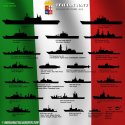Poland, Norway Could Team on Sub Program
By Jaroslaw Adamowski and Gerard O’Dwyer11:14 a.m. EDT September 27, 2015
COMMENTEMAILMORE
WARSAW and HELSINKI — Poland is planning to purchase three submarines armed with cruise missiles by 2023 and the Defense Ministry is considering a joint procurement with other NATO member states, with Norway as a potential partner.
"Poland and Norway share a joint interest, which is ensuring security and stability in the Baltic Sea," said professor Marek Jablonowski, a political scientist from the University of Warsaw. "Poland has intensified efforts … to develop joint projects in the field of defense, mostly with its neighbors. This could be another dimension [of such cooperation]."
Poland’s Deputy Prime Minister and Defense Minister Tomasz Siemoniak, during his Sept. 14 meeting with his Swedish counterpart, Peter Hultqvist, said, "the Baltic Sea has become a dangerous zone, which is why it is necessary and justified to tighten the military cooperation between Poland and Sweden."
Norway’s decision to examine the potential for industrial cooperation with Poland in submarine design and construction stems directly from the similarities between the future sub requirements of both countries, according to Norway’s Ministry of Defense.
A statement from the MoD noted that the commonalities in future needs makes it worthwhile to "investigate cooperation with Poland with regards to procurement, maintenance, sustainment and operations of new submarines. Norway will continue discussions with Poland to investigate the potential for cooperation," the statement said.
Initial discussions over possible industrial cooperation were opened by Polish and Norwegian MoD officials in Kielce, Poland, during the International Defense Industry Exhibition MSPO 2015 event, which was held in the first week of September.
Norway’s six Ula-class submarines were built and delivered to the Norwegian Navy in 1987-1992. Acquisition of spare parts is now becoming a greater challenge for the Navy.
The MoD started a planning process in 2007 to evaluate options pertaining to the future of the Ula-fleet. In 2014, the Norwegian government decided to focus on a new submarine class rather than conducting a life-extension program on the existing Ula vessels.
"A project for new submarines is currently in the definition phase, and a recommendation will be presented to the government in 2016," the MoD said.
Norway plans to adopt an evolutionary approach to the submarine project, framing its procurement on an existing design from an experienced shipyard. The MoD believes this will reduce the need for extensive development, which could potentially add risk and cost.
The Norwegian government is also keen to leverage its advanced submarine technologies and capabilities, including Kongsberg’s combat systems, which are currently in use in the Ula as well as German and Italian U212A-class submarines.
Norway, the MoD said, will use the procurement of new submarines as an opportunity for the country’s defense industry to participate and secure key contracts.
The Ula-class subs are due to reach the end of their operational life in the mid-2020s, so the MoD aims to have all construction contracts signed before 2020.
Norway expects that delivery of the first submarine in the new class will take place around six to seven years after a contract is signed, potentially within the time frame of 2023-2024.
"The procurement cost of new submarines will be substantial. Cooperation in the area of future submarines could be very beneficial in order to achieve economies of scale, cost savings and synergies. Norway is interested in finding long-term partners for an extensive cooperation," the MoD says.
Last September, Poland’s Deputy Defense Minister Czeslaw Mroczek unveiled plans to buy new submarines under a joint procurement with other NATO member states.
Mroczek said the Polish ministry is "considering to jointly acquire the submarines, for instance with Norway and the Netherlands."
Currently, Warsaw and Oslo are exchanging information on their plans related to acquisitions of new submarines for their respective navies. A joint procurement with Norway would allow the Polish government to significantly reduce the program’s cost, according to Mroczek.
"We are completing works on the initial tactical-technical terms, a description of what type of submarines we want to acquire, and with what weapons. It has already been confirmed, and there is no doubt here, that we will acquire cruise missiles for these three vessels," Mroczek told local news agency PAP Sept. 6.
The ministry plans to withdraw its existing submarines from service once new units are delivered to the Navy, he said. Currently, the Polish armed forces own four Kobben-class subs, and one Kilo-class submarine.
This follows an announcement made in May by Siemoniak that the Polish government plans to purchase cruise missiles for the new submarines. Under the plan, Poland is to acquire 24 missiles for the three submarines, of which two are to be delivered to Poland by 2022, and a third by 2023, the Defense Ministry said in its Military Modernization Plan for the years 2013-2022.
In March, Siemoniak announced that Warsaw was in talks with Washington and Paris over the potential cruise missile deal that would be implemented under the ministry's Polish Claws program, which aims to significantly boost Poland’s deterrence capacity.
France, US Could Supply Cruise Missiles
One option is to acquire Tomahawk cruise missiles from the US. The second option regards acquiring naval cruise missiles from France if Poland decides to purchase French-designed Scorpene submarines. Paris has reportedly agreed to procure submarines and long-range missiles for Warsaw, according to information obtained by local daily Gazeta Wyborcza.
Should the deal go through, Poland would become the third country to operate such long-range missiles, along with the US and UK. The Tomahawk is produced by Raytheon.
As earlier reported, Poland aims to launch its submarine tender in the fourth quarter of 2015, according to the Deputy Defense Minister Maciej Jankowski.
Norway is also investigating the potential for cooperation with other nations. Sweden, Poland and the Netherlands are the most obvious industrial partner nations for Norway, said Henk Rutten, an industry analyst based in The Hague.
"It is possible that a future collaboration could include more than two nations. Sweden is certainly an interested party. Although Sweden has not made a formal approach to Norway as yet, there is dialogue at an unofficial level," said Rutten.
Last spring, Lena Erixon, the then-director general of Sweden’s military procurement agency, FMV, identified Norway and the Netherlands as potential partner nations. Sweden and Saab are hoping that Norway will select the new A26 sub, or a variant, as its future submarine type.
The Netherlands is primed to replace its 2,756-ton, life-extended Walrus subs after 2025. The submarines entered service in the 1990s.
Saab is contracted to deliver two A26-class submarines, at an estimated cost of US $1.4 billion, to the Swedish Navy by 2022. However, the budget is fully funded and the program is not dependent on Saab finding an industrial-cooperation partner.
"While the A26 program is fully budgeted, our interest in finding a partner is not so much about reducing the final bill as a desire to reduce future costs. By partnering with other countries we will be able to share both future development and maintenance costs and achieve a more even production volume," said Erixon.
Saab has an industrial teaming agreement with the Dutch Damen Shipyard. The deal reflects the extent of Swedish state backing for Saab in its long-term goal to build a robust and competitive underwater naval capacity centered around Saab Kockum’s underwater division.







